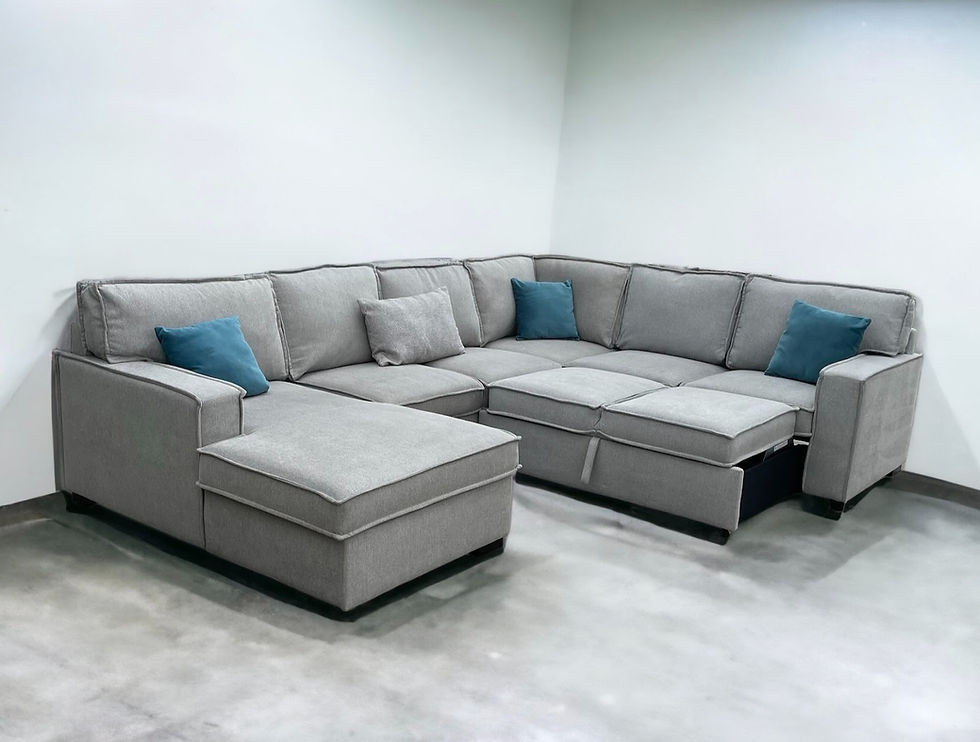Why Buying Refurbished Furniture is Good for the Environment
- Daphne Escoton
- Jul 2, 2024
- 3 min read
Updated: Jul 16, 2024
Every year, millions of tons of furniture end up in landfills. In 2023 alone, approximately 9.7 million tons of furniture waste were reported in American landfills. This immense waste contributes significantly to environmental pollution and the depletion of natural resources. However, by choosing refurbished furniture, we can drastically reduce this waste.

The Benefits of Refurbishing Furniture

1. Resource Conservation
Refurbishing furniture uses significantly fewer raw materials compared to manufacturing new pieces. Here’s a comparison of resource consumption for new and refurbished furniture:
Wood Consumption - The production of new furniture is highly resource-intensive, particularly in terms of wood usage. Refurbished furniture, on the other hand, makes use of existing materials, significantly reducing the demand for new wood.
New Furniture: 100 units
Refurbished Furniture: 30 units (70% reduction)
Water Consumption - Manufacturing new furniture consumes large quantities of water, especially in the processing of raw materials and finishing stages. Refurbished furniture requires far less water since it utilizes pre-existing materials.
New Furniture: 100 units
Refurbished Furniture: 25 units (75% reduction)
Energy Consumption - New furniture production is energy-intensive due to processes like material extraction, manufacturing, and transportation. Refurbished furniture reduces energy consumption significantly by reusing existing materials.
New Furniture: 100 units
Refurbished Furniture: 35 units (65% reduction)

2. Lower Carbon Footprint
The production of new furniture emits higher levels of CO2 due to energy use in manufacturing processes and transportation. Refurbished furniture, on the other hand, results in significantly lower CO2 emissions, contributing to a reduction in global carbon footprints.
3. Preserving Natural Habitats
Manufacturing new furniture often involves deforestation and the extraction of natural resources, which can lead to habitat destruction for countless species. By choosing refurbished furniture, we can help preserve forests and protect biodiversity by reusing materials.
4. Reducing Chemical Use
The production of new furniture involves the use of various chemicals, including paints or finishes, adhesives, and treatments, which can emit volatile organic compounds (VOCs) and contribute to indoor air pollution. Refurbished furniture generally requires fewer chemicals, resulting in healthier indoor environments.
5. Supporting Local Economies
Refurbishing furniture often involves skilled craftsmanship and local labor, supporting community businesses and economies. The refurbishment industry creates jobs in areas such as repair, restoration, and resale, often leading to higher employment opportunities compared to the production of new furniture.

How Joyce's Choices Contributes to Sustainability
1. Reducing Waste
By refurbishing and selling pre-owned furniture, we significantly decrease the amount of waste that ends up in landfills. Every piece of furniture we refurbish is one less item contributing to the growing waste problem.
According to the Environmental Protection Agency (EPA), millions of tons of furniture are discarded each year, and by choosing refurbished options, we help mitigate this issue.
2. Conserving Resources
Refurbishing furniture minimizes the need for new raw materials such as wood, water, and energy, thus conserving natural resources and reducing environmental degradation.
Our commitment to sustainability extends beyond our furniture. We’re proud to partner with One Tree Planted, contributing to global reforestation efforts. For every piece of furniture sold, we plant a tree, helping to restore forests and combat climate change. Through this partnership, Joyce's Choices has planted over 500 trees, making a significant positive impact on the environment.
3. Lowering Emissions
With a lower carbon footprint, refurbished furniture production contributes less to greenhouse gas emissions, helping to combat climate change and promote a healthier planet. The production of new furniture emits high levels of CO2 due to energy-intensive processes and long supply chains. Refurbished furniture, on the other hand, has a much lower carbon footprint.
4. Promoting Circular Economy
By refurbishing and reusing furniture, we promote a circular economy, where products are reused and recycled instead of being discarded. This sustainable practice reduces the demand for new products, conserves resources, and minimizes waste.

By choosing Joyce's Choices, you’re not just getting high-quality, stylish furniture at a fraction of the price; you’re also making a positive impact on the environment. Our commitment to reducing waste, conserving resources, lowering carbon emissions, and supporting local economies ensures that every piece of refurbished furniture contributes to a sustainable future.
And with every purchase, remember that you're also helping to plant a tree, further enhancing our planet's health and biodiversity.




Comments